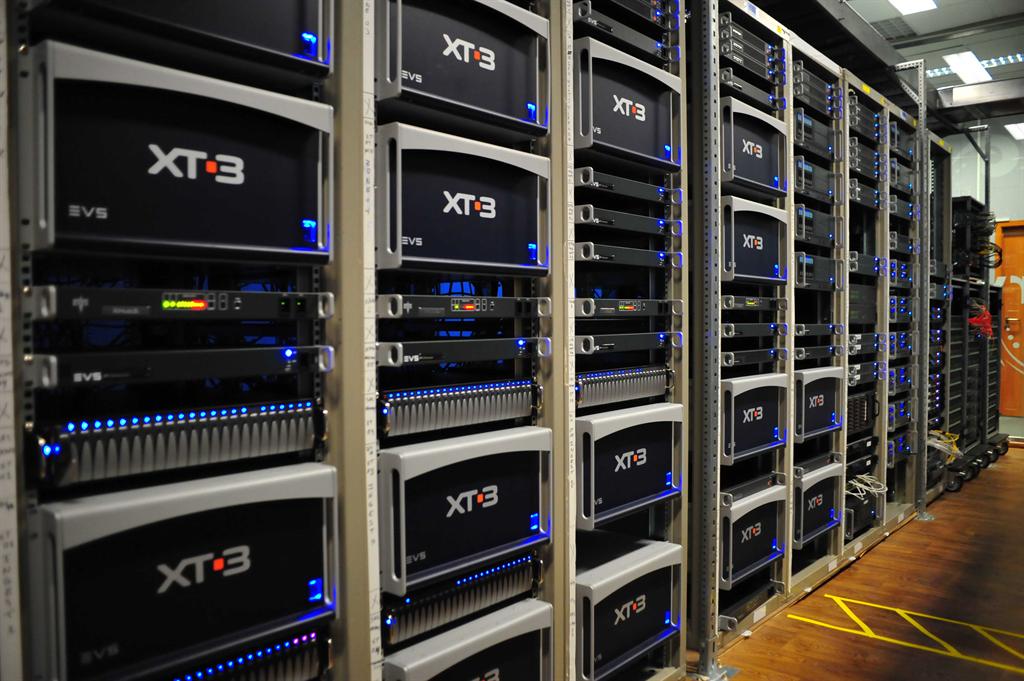Sochi: Servers in Sport

The OBS Media Server in Sochi is composed of XT3 servers for ingest, production and playout, and a central XStoreSAN, mirrored to an Avid ISIS storage system.
SOCHI, RUSSIA—The speed, workflow and networking aspects of server-based ingest and production at big sport events have allowed broadcasters to keep up with rapidly expanding, complex content needs.
In Sochi, host broadcaster Olympic Broadcasting Services deployed a massive server and storage infrastructure. Three thousand hours of Avid ISIS storage, 2000 hours of EVS XSAN storage and 1500 hours of EVS XT3 recording were available, the largest such infrastructure the host has used at a Winter Games.
The system design is somewhat unique—it is a fully-mirrored system of Avid and EVS infrastructures. All delivered content, whether live feeds or host-created ENG content, is recorded to both the Avid and EVS systems.
But OBS, who started using servers in an archive role at the 2006 Torino Games, and is considered one of the first larger organizations to fully adopt file-based content creation and workflows (Beijing, 2008) knows that just having material available is only half the battle.
“We have full metadata consistency between the two (infrastructures),” said Sotiris Salamouris, head of engineering technical operations at OBS. “That has been a big and very extensive integration.”
A bank of 17 EVS XT3s in the IBC record all incoming feeds, and the company’s XTAccess product manages a transcode step and pushes the files to the Avid ISIS. Salamouris said this infrastructure and its very important metadata consistency began in London in 2012, but has been perfected in Sochi: “We have invested a lot of time and effort to take the best from both platforms … we are proud of our unique workflow that has the full capacity of both systems.”

An app from EVS called iXT allowed producers at a venue’s interview zone to tag video and create clips directly in the central server, with metadata. He said the production systems were being used where they best fit the workflow. For OBS, the production heavy Olympic News Channel used an Avid iNews workflow, while EVS servers dominate the playout of the final product, for example.
OBS’ broadcast customers had a few options on how to approach the task of making the big mix of raw content and clips into a final product for use back home. The simplest option was a browse service using an EVS IPDirector seat to help organize the production of the live event feed. Another option involved an IPDirector station using IPBrowse. This allowed a rightsholder to drag full-res clips from the host storage to its own storage.
A third option was the provision of one or more host-provided Avid workstations, full craft NLEs with access to the host ISIS infrastructure. Making a return after a limited debut in London was a host service called IPBrowseWeb, which allows producers and production personnel located offsite to browse content, create clips and even retrieve content with minimal delay over standard Internet connections. This means more bodies can stay at home… so transportation and housing costs will be less. In Sochi Finnish broadcaster YLE was the marquee customer. See the YLE profile.
Servers, of course, also continue to see heavy use outside the main broadcast center, in their historical role as record devices for slow motion playback. EVS reports that more than 200 in total were used for this and other purposes at venues.
ESTABLISHED SERVICES
OBS’ thoughtful deployment of a server infrastructure continues to provide real benefits to RHBs hungry for compelling content. Services include:

OBS loggers added additional metadata to the content using the IP Log module of EVS’ IP Director. Over the years, OBS has used the fundamental file-based nature of its server-based production to offer additional services to RHBs, and these continue to be refined. New this year was a service to help RHBs get compelling content to smart phones, pad devices and computers. At the last Winter Games in Vancouver, the iPad was still two months from its debut. Here in Sochi, the idea of filling a second or third screen with good content had become so popular that 95 countries used the host broadcaster’s new multiplatform service, called the Olympic Video Player (OVP). OBS decided only nine months ago to offer this service in Sochi, rather than waiting for a Rio 2016 rollout as originally planned. Within the large entry hall of the broadcast centre in Sochi, OBS had a demo area of the OVP Service, with several phones and tablets displaying live and clip-based content. Behind glass were the technical areas where transcoding and such was done.
The service offers a-la-carte and turnkey services including on-demand HD video with full commentary; broadcaster commentary audio added to live video; pre-roll videos and commercials; live streaming, including broadcaster channels; a ticker, including broadcaster content promotion; full customisations including language, broadcaster logo etc. One possible feature moving forward is the provision of extra live content to the viewer with unique and unseen camera angles. Finnish broadcaster YLE had big success using the service, as profiled in a story below.
ESTABLISHED SERVICES
OBS’ thoughtful deployment of a server infrastructure continues to provide real benefits to RHBs hungry for compelling content. Services include:
•The ONC, a ready-to-air news channel broadcasting 24 hours per day for the entire length of the Games. Content includes sports highlights, athlete interviews and other features and is played out using EVS XT3 servers controlled by IPDirector. This production workflow relied heavily on Avid NLEs accessing the ISIS mirrored half of the storage infrastructure. For ONC crews, an iPad app from EVS called iXT allowed producers at a venue’s interview zone to tag video and create clips directly in the central media server with metadata related to the content.
•One service that has seen real expansion since its Vancouver launch was the Multichannel Distribution Service, which provided six ready-to-air channels of competition plus the ONC, plus a possible unilateral-based channel, via satellite. OBS used the rapid turnaround inherent in the massive server system to populate the MDS with a mix of live and recorded content. Twenty-some broadcasters of all sizes used the MDS service in Vancouver; in London, more than 90 broadcasters saw its value as a tool to broaden the content they could offer their viewers. More than 100 broadcasters used the service in Sochi.
One new technical feature in Sochi reflected the growth of the service—Harris ADC 100 hardware and software was deployed to automate the playout.
The established host broadcaster service called the Broadcast Data Feed (BDF) was also now offered as a parallel service with MDS, for use by broadcasters doing things like off-tube commentary. This feed had within it all the OBS logs coupled with the IOC-provided Olympic Data Feed. The BDF adds value to all host assets, making them easier to find and providing more information.
The professional video industry's #1 source for news, trends and product and tech information. Sign up below.

